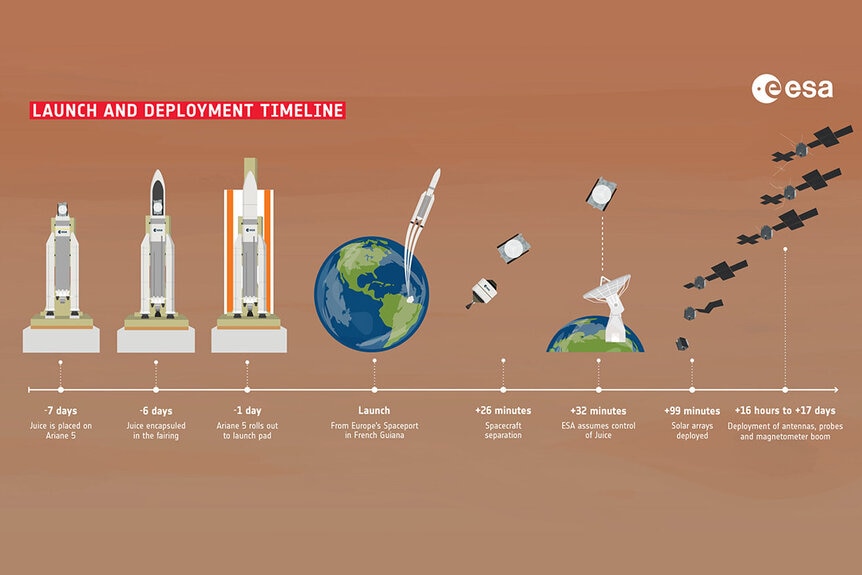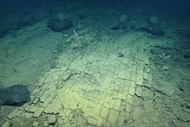Create a free profile to get unlimited access to exclusive videos, sweepstakes, and more!
ESA's 'Jupiter Icy Moons Explorer' launches to JUICE up the search for life on Jovian moons
Worth the squeeze.

Sebastián Cordero’s 2013 sci-fi adventure Europa Report (streaming now on Peacock!) imagines what it might be like when humanity finally sends human astronauts to the surface of Jupiter’s icy moon Europa. Unlike the Apollo program which, despite a couple of hiccups, was a smashing success, this first Europan mission ends in disaster. The crew of Europa One is plagued almost from the beginning by the tragic loss of a crew member only a portion of the way through their trip. By the time they reach Europa, they are already exhausted and demoralized.
Perhaps that’s why, when a crew member reports a strange blue light in the distance, they are dismissed. They have been in space for years, they’re lonely, they are scared and stressed, and they are standing for the first time in human history on a frozen alien world. It’s not surprising some of them are seeing things. It’s also not surprising, because those lights are very real (well, fictionally speaking) and connected to ravenous alien life forms who live in Europa’s subsurface ocean. The crew of Europa One succeed in their mission to find life elsewhere in the solar system, but it’s the last thing they ever do.
RELATED: First closeup picture of Europa in 20 years reveals rugged terrain and degraded crater
Now, in real life, the European Space Agency (ESA) is planning their own mission to Jupiter’s icy moon(s), one which hopefully results in less tragedy and more discovery. The agency’s JUpiter ICy moons Explorer (JUICE) launched today, April 14, at 14:14 CEST (8:14 a.m. ET). The spacecraft launched aboard an Ariane 5, the ESA’s heavy lift space launch vehicle, from Europe’s spaceport in Kourou. You can watch the mission's progress on ESA Web TV or on their YouTube channel.
After the launch, the spacecraft will separate from the rocket’s upper stage, establish a signal with Earth, and deploy its solar array. Two monitoring cameras will observe the deployment and send images back to Earth. Over the next couple of weeks, JUICE will empty its pockets and deploy a number of antennae and instruments before beginning its eight year journey to Jupiter.
That trip will involve four gravity assists to change course and pick up speed before heading into the emptiness of interplanetary space. The first gravity assist will happen in August and it’s actually two boosts in one. JUICE will first fly past the Moon and build up some steam. A day and a half later it will do a flyby of Earth to snag another boost.
Approximately eight years after launch, it will arrive in the Jovian system and get to work. The spacecraft will focus on three of Jupiter’s largest moons: Ganymede, Callisto, and Europa and their interplay with the planet. The goal is twofold: to study the system as a model for gas giants around other stars and to look for signs of alien life. Using a suite of instruments, JUICE will characterize the moons as potential habitats for life, either now or in the past.
IS THERE LIFE ON JUPITER’S MOONS?
We think of life as only existing, or being capable of existing, within a narrow band around a star; we call that band the habitable zone. That’s the area around a star where temperatures allow liquid water to exist. Too close and your water could boil off, too far and it freezes solid. In our own solar system, the habitable zone reaches from about mid-way between Venus and Earth to just beyond Mars. Jupiter and the rest of the gas and ice giants are just too far away from the Sun to make nice vacation spots. Or so we thought.
Astronomers still believe that life wouldn’t do well on a world like Jupiter (at least not the sort of life we’re used to) but it might have a shot in the Jovian ‘burbs. JUICE’s three moon targets are each believed to have oceans of liquid water beneath their frozen surfaces which could provide a cozy environment for extraterrestrials. There are other considerations, of course. For instance, on Ganymede, scientists believe the water becomes ice again when you get deep enough, which might mean the liquid water has no contact with the rocky surface. That’s important if you want heat or nutrients from tectonic activity.
RELATED: It may be snowing upside down in the water beneath Europa’s surface
On Europa, that doesn’t appear to be an issue. The great gravitational tug of war happening between Jupiter and its dozens of moons presses and pulls Europa, generating heat in its core. That heat moves toward the surface, warming the water. Similar Earthly ecosystems set up shop around thermal vents on the seafloor, resulting in rich ecosystems thriving in the dark, far from the reach of sunlight. It’s possible something similar is happening on Europa and missions like JUICE might help us find out.
However, JUICE won’t focus solely on Europa, but will make a total of 35 flybys of the three target moons. There are also some pretty obvious limitations. If life does exist on Europa, Ganymede, or Callisto, it’s likely hiding in the hidden ocean and may not deliver any sign of their presence to the surface. JUICE will be spying from hundreds of miles above the moons as it whizzes through the system. If any life wants to make their presence known, they’re going to need a neon sign.
NASA’s own Europa Clipper mission is also headed to the Jovian moon next year. While it will launch well after JUICE, Europa Clipper will take a more direct route and arrive at Europa almost a year ahead of the ESA craft. Moreover, Europa is Clipper’s primary focus. If any spacecraft is going to find signs of life there, our money is on Clipper. However, whether you’re a scientist or a space probe, two sets of eyes are better than one. And we’re going to need all the help we can get.
Hope for the best but prepare for the worst, with Europa Report, streaming now on Peacock!




























